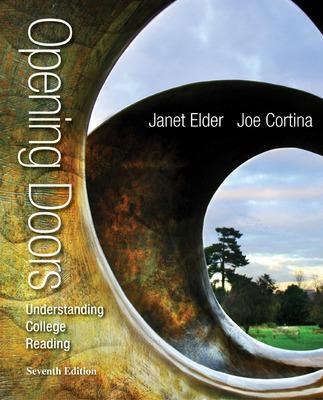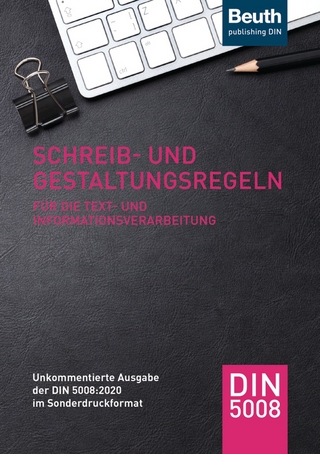
Opening Doors
McGraw-Hill Professional (Verlag)
978-0-07-351351-5 (ISBN)
JANET ELDER was graduated summa cum laude from the University of Texas in Austin with a B.A. in English and Latin. She is a member of Phi Beta Kappa. She was the recipient of a government fellowship for Southern Methodist University's Reading Research Program, which resulted in a master's degree. Her Ph.D. in curriculum and instruction in reading is from Texas Woman's University where the College of Education presented her the Outstanding Dissertation Award. She established the first comprehensive secondary reading program in the Dallas Independent School District, and has conducted extensive staff development training for Dallas area teachers. After teaching reading and study skills courses at Richland for several years, she was asked to develop and implement an honors program for the college. After coordinating the honors program during its first six years, she resumed teaching full time. In addition to teaching reading courses, Dr. Elder periodically serves on interdisciplanary teaching teams for honors English and humanities courses. She has served on a task force that re-evaluated Richland's writing-across-the-curriculum program. She has twice received the Extra Mile Award from special services (disabilities) students, has twice been her division's Piper Award nominee for excellence in teaching, and in 1993 received an Excellence Award from the National Institute for Staff and Organizational Development. In 1999 she was one of three nominees for Richland's Excellence in Teaching Award. A frequent presenter at professional conferences and inservice workshops, she has a deep interest and expertise in brain friendly instruction. JOE CORTINA earned his B.A. degree in English from San Diego State University and his master's degree and doctoral degree in curriculum and instruction in reading from the University of North Texas. He has taught undergraduate teacher education courses in reading at the University of North Texas and Texas Woman's University. In 1981 he was selected to represent the Dallas County Community College District as a nominee for the Piper Award for Teaching Excellence. In addition, Dr. Cortina was selected as his divisions nominee for Richland's Excellence in Teaching Award in 1987, 1988 and 1993. In 1992 he was selected as an honored alumnus by the Department of Elementary, Early Childhood and Reading Education, of the University of North Texas and in 1994 he was a recipient of an Excellence Award given by the National Institute for Staff and Organizational Development. In addition to teaching reading courses at Richland College, he has served on interdisciplinary teaching teams for honors English courses and has served as a faculty leader of Richland's writing-across-the-curriculum program. Dr. Cortina has served on the conference program committees for both the College Reading and Learning Association and the National Association for Developmental Education. He has also served as a member of the editorial advisory board of The Journal of Adolescent and Adult Literacy. He is a frequent speaker at professional meetings and inservice workshops.
* - New reading selections for this editionTo the Instructor: Getting Started in Opening DoorsTo the StudentPART ONE: ORIENTATION: PREPARING AND ORGANIZING YOURSELF FOR SUCCESS IN COLLEGE
CHAPTER ONE: MAKING YOURSELF SUCCESSFUL IN COLLEGESkillsDoing What Successful Students DoMotivating YourselfSetting Your GoalsIdentifying How You Prefer to Learn Mananging Your TimeSetting Up a Weekly Study Schedule Making the Most of Your Study TimePlanning Further Ahead: Creating a Monthly Assignment Calendar and Using a Daily To Do ListCreating Your Summary: Developing Chapter Review CardsReadings *Selection 1-1 “Why Go to College" from P.O.W.E.R. Learning: Strategies for Success in College and Life by Robert S. Feldman (Student Success)*Selection 1-2 “Getting Ready for Prime Time: Learning the Skills Needed to Succeed Today and Tomorrow” from Understanding Business by William Nickels, James McHugh, and Susan McHugh(Business)*Selection 1-3 “Saved” from The Autobiography of Malcom X, as told to Alex Haley (Literature)
CHAPTER TWO: APPROACHING COLLEGE READING AND DEVELOPING A COLLEGE-LEVEL VOCABULARYSkills Understanding the Reading ProcessImproving Your ReadingPredicting as You ReadMonitoring Your Comprehension Adjusting Your Reading RateDeveloping a College-Level VocabularyUsing Context CluesUsing Word-Structure ClassUsing a Dictionary Pronunciation KeyUnderstanding Denotations and Connotations of WordsUnderstanding Figurative LanguageA Word about Standardized Reading Tests: Context Clues and Figurative LanguageCreating Your Summary: Developing Chapter Review CardsTest Your Understanding: Context Clues, Part 1Test Your Understanding: Context Clues, Part 2Test Your Understanding: Word-Structure, Part 1Test Your Understanding: Word-Structure, Part 2Test Your Understanding: Figurative Language, Part 1Test Your Understanding: Figurative Language, Part 2Readings*Selection 2-1 “Making It Happen: Creating Positive Change to Become a Peak Perfomer” from Peak Performance: Success in College and Beyond by Sharon K. Ferrett (Student Success) *Selection 2-2 “Terrorism in a Global Age” from Nation of Nations: A Narrative History of the American Republic by James Davidson et al. (History)*Selection 2-3 “A Whale of a Survival Problem” from The Nature of Life by John Postlehwait and Janet Hopson (Biology)
CHAPTER THREE: APPROACHING COLLEGE ASSIGNMENTS: READING TEXTBOOKS AND FOLLOWING DIRECTIONSSkillsCollege Textbooks: Methods for Reading and Studying EffectivelyThe SQ3R Study SystemThe Three-Step Process for Reading and Studying TextbooksStep 1: Prepare to ReadStep 2: Ask and Answer Questions to Enhance your ReadingStep 3: Review by Rehearsing the Answers to Your Questions Following Directions in Textbooks and on TestsGuidelines for Following DirectionsCreating Your Summary: Developing Chapter Review CardsReadings*Selection 3-1 “African Americans: The Struggle for Equality” from The American Democracy by Thomas E. Patterson(Government)*Selection 3-2 “Parenthood: Now, Later,...Never?” from Human Development by Diane E. Papalia, Sally Wendkos Olds, and Ruth Feldman(Human Development)*Selection 3-3 “Art in the Service of Religion” from Living with Art by Rita Gilbert (Art Appreciation)
PART TWO: COMPREHENSION: UNDERSTANDING COLLEGE TEXTBOOKS BY READING FOR IDEASCHAPTER FOUR: DETERMINING THE TOPIC AND THE STATED MAIN IDEASkillsThe Topic of a ParagraphWhat is the Topic of a Paragraph, and why is it important?Determining and Expressing the Topic The Stated Main Idea of a ParagraphWhat is a stated main idea, and why is it important? Locating the Stated Main Idea SentenceHow to tell if you have identified the stated main idea sentenceHow to avoid two common errors in locating a stated main ideaStated Overall Main Ideas in Longer PassagesA Word about Standardized Reading Tests: Topics and Stated Main IdeasCheckpoint: Locating the Stated Main IdeaCreating your Summary: Developing Chapter Review CardsTest Your Understanding: Determining the Topic and the Stated Main Idea, Part 1Test Your Understanding: Determining the Topic and the Stated Main Idea, Part 2Readings*Selection 4-1 "A Warning to Students: Plagiarism, Term Papers, and Web Research” from Using Information Technology: A Pratical Introduction to Computers and Communication by Brian K. Williams and Stacy C. Sawyer(Information Technology)*Selection 4-2 “Classes without Walls: Distance Learning” from P.O.W.E.R. Learning: Strategies for Success in College and Life by Robert S. Feldman(Student Success)*Selection 4-3 “Muhammad” from The 100: A Ranking of the Most Influential Persons in History by Michael K. Hart (History)
CHAPTER FIVE: FORMULATING IMPLIED MAIN IDEASSkills Implied Main Ideas in ParagraphsWhat is an Implied Main Idea?Why is formulating implied main ideas important?Formulating an Implied Main IdeaSteps to FollowThree Formulas for Using Information in a Paragraph to Formulate the Main IdeaRequirements for Correctly Formulated Main Idea SentencesImplied Overall Main Ideas in Longer PassagesA Word about Standardized Reading Tests: Implied Main IdeasCheckpoint: Formulating Implied Main IdeasCreating Your Summary: Developing Chapter Review CardsTest Your Understanding: Formulating Implied Main Ideas, Part 1Test Your Understanding: Formulating Implied Main Ideas, Part 2Readings*Selection 5-1 “Identity Theft: You are at Risk” from several internet sources (Personal Finance)*Selection 5-2 “Violence in Television and Video Games: Does the Media's Message Matter?” from Esentials of Understanding Psychology by Robert S. Feldman (Psychology)
CHAPTER SIX: Identifying Supporting DetailsSkills Supporting Details in ParagraphsWhat are Supporting Details?Why are Supporting Details important?Identifying and Listing Supporting Details Major and Minor Detail, and How to Tell the DifferenceA Word about Standardized Reading Tests: Supporting DetailsCheckpoint: Identifying Supporting DetailsCreating Your Summary: Developing Chapter Review CardsTest Your Understanding: Identifying Supporting Details, Part 1Test Your Understanding: Identifying Supporting Details, Part 2Readings*Selection 6-1 “Shaping Your Health: The Millennial Generation and Early Adulthood” from Understanding Your Health by Wayne A. Payne, Dale B. Hahn, and Ellen B. Lucas (Health)*Selection 6-2 “Quacks and Quackery” from Concepts of Fitness and Wellness by Charles Corbin, Greg Welk, William Corbin, and Karen Welk (Health)*Selection 6-3 “What Can Be Done to Help Third World Countries” from A Beginner's Guide to the World Economy by Randy Charles Epping (Economics)
CHAPTER SEVEN: Recognizing Authors’ Writing PatternsSkills Patterns of Writing What are authors' writing patterns?Why is recognizing writing patterns important?Recognizing Author's Writing Patterns List PatternSequence PatternDefinition PatternComparison-Contrast PatternCause-Effect PatternSpatial Order PatternAvoid Seeing Everything as a List PatternCheckpoint: Recognizing Authors’ Writing PatternsOther Writing PatternsAddition PatternGeneralization and Example PatternStatement and Clarification PatternSummary PatternMixed PatternCheckpoint: Other Writing PatternsRelationships within and between Success1.Clarification2.Example3.Addition4.Sequence5.Comparison6.Contrast7.Cause-Effect8.Problem-Solution9.Spatial Order10.Summary/Conclusion11.ConcessionA Word about Standardized Reading Tests: Authors' Writing PatternsCheckpoint: Relationships within and between SentencesCreating Your Summary: Developing Chapter Review CardsTest Your Understanding: Basic Writing Patterns, Part 1Test Your Understanding: Recognizing Authors’ Writing Patterns, Part 2Readings*Selection 7-1 “E-Commerce? It's E-Normous” from Understanding Business by William Nickels, James McHugh and Susan McHugh(Business) *Selection 7-2 “The Development of Rock Music and Rock in American Society” from Music: An Appreciation by Roger Kamien (Music Appreciation)*Selection 7-3 “Reactions to Impending Death” from Essentials of Psychology by Dennis Coon (Psychology)
CHAPTER EIGHT: Reading CriticallySkills What Is Critical Reading?Critical Reading SkillsDetermining an Author's Purpose and Intended AudienceDetermining an Author's Point of View, Tone, and Intended MeaningA Word about Standardized Reading Tests: Critical ReadingCheckpoint: Reading CriticallyCreating Your Summary: Developing Chapter Review CardsTest Your Understanding: Reading Critically, Part 1Test Your Understanding: Reading Critically, Part 2Readings*Selection 8-1 "Prologue" from The Illustrated Man by Ray Bradbury (Literature)*Selection 8-2 “Think Before You Speak: Public Speaking in a Multicultural World” from The Art of Public Speaking by Stephen E. Lucas (Speech Communication) *Selection 8-3 From The Things They Carried by Tim O'Brien (Literature)
CHAPTER NINE: Thinking CriticallySkills What Is Thinking Critically, and Why Is It Important? Critical Reading SkillsWhy Readers Fail to Think CriticallyDistinguishing Facts from Opinions and Determining Whether Opinions are Well SupportedEvaluating an Author's AgreementIdentifying Propaganda DevicesA Word about Standardized Reading Tests: Critical ThinkingCheckpoint: Thinking CriticallyCreating Your Summary: Developing Chapter Review Cards Test Your Understanding: Thinking Critically, Part 1Test Your Understanding: Thinking Critically, Part 2Readings*Selection 9-1 “Poverty in America and Improving Social Welfare through Public Education” from The American Democracy by Thomas E. Patterson(Government)*Selection 9-2 “Your Financial Wellness” from Connect Core Concepts in Health by Paul Insel and Walton Roth(Health) *Selection 9-3 “Our Ecological Footprint: Do We Consume Too Much” from Environmental Science" A Study of Interrelationships by Eldon Enger and Bradley Smith (Environmental Science)
PART THREE: SYSTEMS FOR STUDYING TEXTBOOKS: DEVELOPING A SYSTEM THAT WORKS FOR YOU
CHAPTER TEN: SELECTING AND ORGANIZING TEXTBOOK INFORMATIONSkills Studying Better Rather than HarderThree Keys to Studying College TextbooksKey 1: SelectivityKey 2: OrganizationKey 3: RehearsalMaking Textbooks: Underlining, Highlighting, and AnnotatingTaking Notes from Textbooks: Outlining, Mapping, and SummarizingTaking Notes on a LaptopGuidelines for OutliningGuidelines for the Cornell Method of Note-TakingGuidelines for MappingGuidelines for SummarizingGuidelines for Interpreting Graphs and Visual AidsHow Can You Interpret Visual Aids?Bar Graphs Line Graphs Pie ChartsTablesPhotographsDiagramsMapsCartoonsCreating Your Summary: Developing Chapter Review CardsReading *Selection 10-1: “The Age of Globalization” from American History: A Survey by Alan Brinkley(History)
CHAPTER ELEVEN: REHEARSING TEXTBOOK INFORMATION AND PREPARING FOR TESTSSkills Rehearsal and MemorYStudying for TestsGeneral GuidelinesFive-Day Test Review PlanCreating Review Cards to Prepare for a TestCreating Test Review SheetsCreating Your Summary: Developing Chapter Review Cards
ESSENTIAL SKILLS REVIEW TESTS 1-10Appendix 1 Glossary of Key Reading and Study Skills TermsAppendix 2 A List of Word Parts: Prefixes, Roots, and SuffixesAppendix 3: Master Vocabulary List
CreditsIndex
| Erscheint lt. Verlag | 16.2.2013 |
|---|---|
| Zusatzinfo | 66 Illustrations, unspecified |
| Sprache | englisch |
| Maße | 185 x 231 mm |
| Gewicht | 1275 g |
| Themenwelt | Schulbuch / Wörterbuch ► Erwachsenenbildung |
| Schulbuch / Wörterbuch ► Wörterbuch / Fremdsprachen | |
| Geisteswissenschaften ► Sprach- / Literaturwissenschaft ► Literaturwissenschaft | |
| Geisteswissenschaften ► Sprach- / Literaturwissenschaft ► Sprachwissenschaft | |
| ISBN-10 | 0-07-351351-2 / 0073513512 |
| ISBN-13 | 978-0-07-351351-5 / 9780073513515 |
| Zustand | Neuware |
| Haben Sie eine Frage zum Produkt? |
aus dem Bereich


